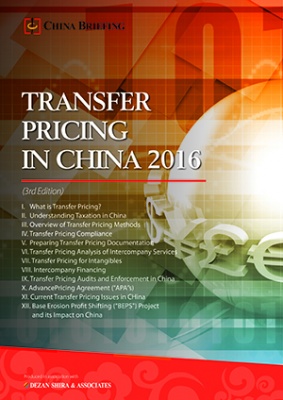
Transfer Pricing in China 2016
Published: May 2016Transfer Pricing in China 2016, written by Sowmya Varadharajan in collaboration with Dezan Shira & Associates and Asia Briefing, explains how transfer pricing functions in China. It examines the various transfer pricing methods that are available to foreign companies operating in the country, highlights key compliance issues, and details transfer pricing problems that arise from intercompany services, intercompany royalties and intercompany financing.
No. of Pages: 140 pages
ISBN: 978-988-14804-7-7
Transfer pricing is a reality for any multinational company. As a result of a globalized economy and increasing complexity in business models, tax authorities around the world are actively protecting their revenue base through the introduction of transfer pricing regimes, which focus on the taxation of profits that stem from related party transactions. These transfer pricing regimes will typically provide guidance to taxpayers on how related party transactions should be priced and how taxpayers can discharge the burden of proof that their transfer pricing arrangements comply with the arm’s length standard.
If designed and implemented early in a business life, a transfer pricing system can complement and support an MNC’s business model and commercial objectives, as well as optimize its global effective tax rate.
The Chinese tax authorities have embraced this growing trend of introducing transfer pricing regimes. In 2009, China formally introduced comprehensive transfer pricing regulations. Since then, China has also been a key player in the development of the United Nations Transfer Pricing Guidelines for Developing Countries, as well as the Organization of Economic Cooperation and Development (“OECD”)’s initiative and action plan on Base Erosion and Profit Shifting (“BEPS”).
Transfer Pricing in China 2016, written by Sowmya Varadharajan in collaboration with Dezan Shira & Associates and Asia Briefing, explains how transfer pricing functions in China. It examines the various transfer pricing methods that are available to foreign companies operating in the country, highlights key compliance issues, and details transfer pricing problems that arise from intercompany services, intercompany royalties and intercompany financing.
- Base Erosion Profit Shifting (“BEPS”) Project
- Introduction
- Impact of BEPS on China
- Revisions to China’s transfer pricing rules in a post-BEPS environment
- Advance Pricing Agreements (“APA”s)
- Introduction
- Categorization of APAs
- Administrative guidance on APAs
- Key APA Statistics
- In summary
- Intercompany Financing
- Introduction
- Alternative approach: the arm’s length debt test
- Recent developments on thin capitalization and intercompany financing
- Growth of China as a treasury hub
- Transfer Pricing Analysis of Intercompany Services
- Introduction
- Transfer pricing analysis of intra-group services
- China’s position on intercompany services
- SAT Announcement No. 16
- Concluding remarks
- Transfer Pricing Compliance
- Tax Return Compliance
- Transfer pricing documentation compliance
- Penalties and fines arising from transfer pricing non-compliance
- Understanding Taxation in China
- China’s tax system
- Tax collection and enforcement
- Need for Transfer Pricing in China
- Transfer pricing regulatory timeline
- What is Transfer Pricing?
- Transfer pricing at a glance
- Arm’s length principle
- Transactions entered into by multinational corporations
- The increasing prominence of transfer pricing
- Overview of Transfer Pricing Methods
- Comparability factors
- Transfer pricing methods
- Selection and application of transfer pricing method
- Preparing Transfer Pricing Documentation
- Introduction
- Group and Company Overview
- Industry analysis
- Functional analysis
- Transfer pricing design and policy
- Economic Analysis
- Chinese Transfer Pricing Documentation requirements
- Tips for preparing documentation
- Transfer Pricing for Intangibles
- What is an intangible asset?
- Intercompany royalties
- Contract R&D arrangements
- Cost sharing agreements
- Concluding remarks
- Transfer Pricing Audits and Enforcement in China
- Overview
- Audit target
- Transfer Pricing Audit Process
- Using the expert panel to resolve transfer pricing audits
- Penalties and interest
- Mutual Agreement Procedures
- Audit trends
- Tips for managing a transfer price audit
- Current Transfer Pricing Issues in China
- Comparability analysis
- Location Specific Advantages
- Intangibles
- Transfer pricing analysis of contract and toll manufacturers
- Sales, marketing and distribution activities
- Use of the Profit Split method
- Conclusion

